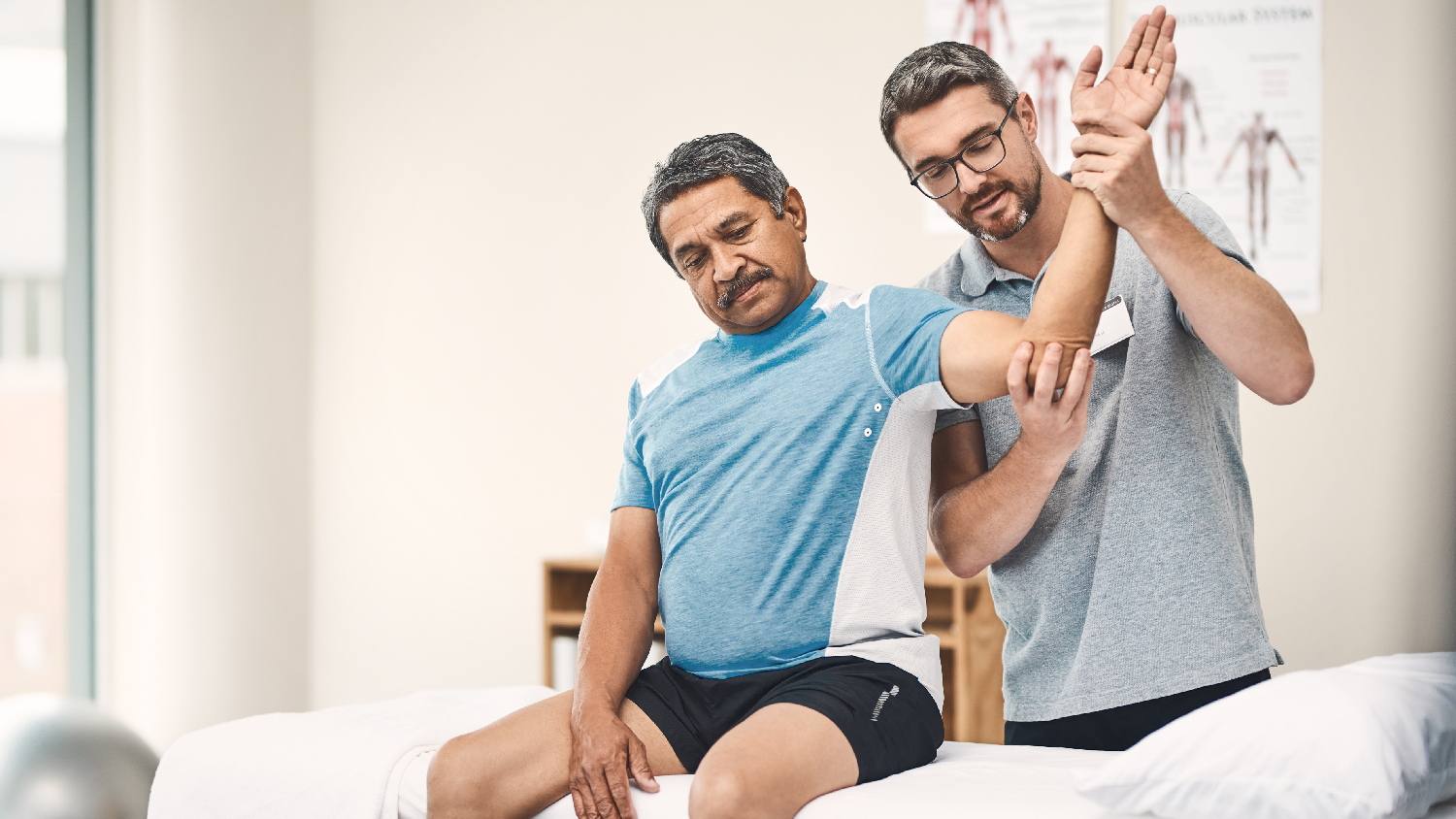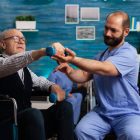Synopsis
Managing chronic knee discomfort, especially that stemming from arthritis, requires expert therapeutic intervention to maintain joint function and quality of life. Specialized knee joint pain physiotherapy protocols focus on strengthening the muscles supporting the joint, thereby reducing the load on the cartilage and managing a persistent physio for sore knee. This article details the vital role of physiotherapy for knee pain in improving mobility and preventing further deterioration. Finding a certified knee physiotherapist is crucial for a personalized program that integrates manual therapy and controlled exercises. We explore the benefits of targeted physio exercise for knee pain, which is essential for long-term joint health. The continuous guidance of a dedicated knee physio ensures safe and progressive rehabilitation. Consistent knee joint pain physiotherapy is the cornerstone of non-surgical management. Addressing a chronic physio for sore knee requires a specialized plan. Expert physiotherapy for knee pain protocols minimize discomfort and maximize functional capacity. A dedicated knee physiotherapist ensures exercises are adapted to the condition’s severity. Utilizing specific physio exercise for knee pain strengthens vital support structures. Relying on a professional knee physio accelerates the journey to wellness. Comprehensive knee joint pain physiotherapy and expert management of a chronic physio for sore knee are essential. Targeted physiotherapy for knee pain and precise physio exercise for knee pain protocols ensure functional gains, proving the value of a certified knee physiotherapist and dedicated knee physio.
Table of Contents
- The Debilitating Impact of Chronic Knee Pain
- The Core Principles of Knee Joint Pain Physiotherapy
- Why You Need a Certified Knee Physiotherapist
- Effective Physio Exercise for Knee Pain for Structural Support
- Addressing the Root Cause- Beyond the Physio for Sore Knee Symptom
- The Holistic Value of Physiotherapy for Knee Pain
- Achieving Long-Term Resilience with Consistent Knee Physio
- The Orthocure Advantage- Integrated Knee and Joint Solutions
- Partnering with Orthocure for Enduring Knee Health
The Debilitating Impact of Chronic Knee Pain
Chronic knee pain, a prevalent condition across the spectrum of age and activity, fundamentally compromises an individual’s independence and quality of life. Whether the pain arises from degenerative conditions like osteoarthritis, the residual effects of a ligament injury, or long-standing biomechanical flaws, the discomfort can severely limit basic functional movements such as walking, stair climbing, and standing for prolonged periods. The constant presence of a physio for sore knee often triggers a vicious cycle of inactivity, which leads to muscle atrophy and accelerated joint wear. Breaking this negative pattern demands specialized and systematic intervention that not only alleviates the pain but also structurally supports the joint for the long term.
The Core Principles of Knee Joint Pain Physiotherapy
Knee joint pain physiotherapy is centered on restoring the functional capacity of the knee through controlled, therapeutic movement and strategic muscle strengthening. The core principle involves reducing the mechanical load on the compromised joint surfaces—a strategy particularly vital in managing arthritis. This is achieved by strengthening the key dynamic stabilizers of the knee, namely the quadriceps (especially the VMO muscle) and the gluteal muscles. Effective knee joint pain physiotherapy systematically guides the patient through progressive exercises, ensuring that power and endurance are rebuilt safely, thereby mitigating pain and slowing the progression of joint deterioration. This process emphasizes a dynamic balance between mobility and stability.
Why You Need a Certified Knee Physiotherapist
The success of knee rehabilitation is intrinsically linked to the expertise of the clinician. A certified knee physiotherapist possesses the critical knowledge to perform a differential diagnosis, distinguishing pain originating locally from that referred from the hip, foot, or spine. This specialist designs a highly customized plan that integrates advanced manual therapy, corrective taping, and precise exercise prescription. Furthermore, a skilled knee physiotherapist understands the nuances of joint loading, ensuring that the chosen physiotherapy for knee pain techniques are adapted to the specific grade of injury or stage of arthritis. Their continuous guidance is essential for ensuring exercises are performed with the correct form, preventing aggravation of the painful physio for sore knee and maximizing structural gains.
Effective Physio Exercise for Knee Pain for Structural Support
The therapeutic exercise component is the most transformative element of any knee program. An expert-designed physio exercise for knee pain routine focuses on building functional strength across the entire lower kinetic chain, not just the quadriceps. This involves targeted strengthening of the hip abductors and external rotators (gluteal muscles), which are crucial for maintaining proper lower limb alignment during walking and running. These physio exercise for knee pain routines are progressed systematically, starting with low-impact, closed-chain movements and evolving into high-level balance and proprioception training. This focus on global strength ensures the knee is dynamically supported, reducing the stress on ligaments and cartilage.
What role do gluteal muscles play in knee stability?
Addressing the Root Cause- Beyond the Physio for Sore Knee Symptom
Effective treatment must penetrate beyond the symptom of a physio for sore knee to address the mechanical root cause of the discomfort. For many, this involves correcting faulty foot biomechanics, such as excessive pronation (flat feet), which leads to the knee joint collapsing inward and chronic rotational strain. A specialist uses diagnostic tools to analyze the foot and gait, often recommending custom foot orthotics to establish a stable foundation and correct the lower limb axis. This holistic strategy, which is integral to modern physiotherapy for knee pain , ensures that the underlying systemic issues contributing to joint deterioration are neutralized, offering a durable solution and preventing compensatory pain elsewhere.
How does flat foot posture affect knee loading?
The Holistic Value of Physiotherapy for Knee Pain
The value of physiotherapy for knee pain extends far beyond muscle strengthening; it provides a comprehensive, non-invasive pathway to functional restoration. The specialist integrates pain management modalities—such as cold therapy, TENS, or therapeutic laser—with hands-on manual therapy to reduce stiffness and improve localized circulation. This combination of relief and structural work is essential for managing the acute phases of injury or arthritis flare-ups. The goal is to empower the patient with the knowledge of joint protection strategies and ergonomic modifications needed for long-term self-management, proving that specialized care is the most effective approach to chronic joint health.
What manual therapy techniques are used to mobilize the knee cap?
Achieving Long-Term Resilience with Consistent Knee Physio
Achieving long-term resilience requires a commitment to a maintenance plan guided by a professional knee physio . The benefits gained through intensive knee joint pain physiotherapy must be preserved through consistent adherence to a specialized home exercise program. This continued vigilance, supervised by a knee physio , is particularly important for managing degenerative conditions and preventing a relapse of the painful physio for sore knee symptoms. The specialist empowers the patient to transition from being a passive recipient of treatment to an active manager of their joint health, ensuring that the effects of the targeted physio exercise for knee pain are sustained indefinitely, promoting an active lifestyle.
The Orthocure Advantage- Integrated Knee and Joint Solutions
ORTHOCURE CLINICS AND GYMS distinguishes itself by offering an unparalleled 360-degree solution for chronic knee problems. Our unique 4 Point Protocol ensures that every treatment plan, overseen by a certified knee physiotherapist , is standardized, precise, and focused on Structural Correction. Our integrated team—Orthopaedic Doctors, Physiotherapists, Chiropractors, and Medical Fitness experts—collaborate to provide comprehensive care. We utilize advanced, globally acclaimed technology, including FootBalance, Finland for custom foot orthotics and the specialized MedX, USA machines for isolating and strengthening the precise muscles needed for joint support. This multi-disciplinary approach guarantees a durable solution for patients suffering from persistent joint pain.
How does Orthocure use the MedX machine for knee rehabilitation?
Partnering with Orthocure for Enduring Knee Health
The services offered by ORTHOCURE CLINICS AND GYMS provide a complete pathway to achieving and maintaining enduring knee health. We deliver expert physio exercise for knee pain and comprehensive physiotherapy for knee pain protocols, prioritizing non-surgical, evidence-based solutions. The ultimate USP of ORTHOCURE CLINICS AND GYMS is its dedication to Structural Correction over temporary relief, ensuring the root cause of the discomfort is permanently addressed. By partnering with a dedicated knee physio team at Orthocure, you gain access to a protocol-driven pathway that guarantees the highest standard of care and a confident return to an active, pain-free life.
FAQs
When should I seek professional help for a persistent physio for sore knee?
You should seek professional help for a persistent physio for sore knee if the discomfort lasts more than two weeks, interferes with your sleep, or prevents you from performing essential daily activities like walking or climbing stairs. Early intervention with specialized knee joint pain physiotherapy is crucial because it can prevent acute symptoms from becoming chronic, which is essential for managing the long-term prognosis of conditions like early-stage arthritis. A specialist can accurately diagnose the root cause, which may be far from the knee itself, such as a hip or foot imbalance, and begin a tailored program immediately. Waiting too long can lead to compensatory movements and muscle weakening, making the recovery process significantly longer.
What is the difference between general fitness and prescribed physio exercise for knee pain?
Prescribed physio exercise for knee pain is highly specific, medically supervised, and focused on functional restoration, unlike general fitness which targets overall conditioning. A qualified knee physiotherapist designs exercises to target muscles essential for stabilizing the knee joint (such as the VMO or gluteals), often using specialized equipment to isolate these weakened areas without overloading the painful joint. These routines are phased, starting with non-weight-bearing movements and progressing to functional training, ensuring safe tissue healing. The exercises are an integral part of the overall knee pain and physiotherapy plan, ensuring structural support and correcting biomechanical faults.
How does a knee physiotherapist address the root causes during physiotherapy for knee pain?
A knee physiotherapist addresses root causes during physiotherapy for knee pain by employing a holistic assessment of the entire kinetic chain, recognizing that the knee is often the victim, not the culprit. They check for misalignments in the feet, weakness in the core and hip muscles, and mobility restrictions in the ankle. The subsequent treatment, which is the full scope of knee joint pain physiotherapy, involves not just localized manual therapy but also targeted strengthening of the hip and core. This integrated approach corrects the abnormal forces being transferred to the knee joint, which is essential for managing chronic conditions and preventing recurrence.
What is the expected timeline for improvement when undergoing knee joint pain physiotherapy?
The timeline for improvement when undergoing knee joint pain physiotherapy varies significantly based on the underlying condition and its severity. Acute issues, such as a mild strain or a sudden flair-up of a physio for sore knee, may show significant relief within 3-4 sessions (2-3 weeks). Chronic or degenerative conditions, however, such as advanced arthritis or post-surgical rehabilitation, may require a structured program spanning several months. Consistency with prescribed physio exercise for knee pain at home is a critical factor influencing the speed of recovery. Regular reassessments by the knee physio allow for the treatment plan to be dynamically adjusted, ensuring optimal and accelerated progress.
What role does knee pain and physiotherapy play in managing chronic conditions like osteoarthritis?
Knee pain and physiotherapy play a critical, non-surgical role in managing chronic conditions like osteoarthritis by focusing on joint preservation and pain mitigation. The therapist helps patients maintain and increase joint mobility through gentle range-of-motion exercises and manual therapy, which helps to minimize stiffness. Crucially, they use specific physio exercise for knee pain to strengthen the surrounding muscles, creating a dynamic support system that offloads the joint cartilage, which is essential for reducing pain and improving the quality of life. This strategy helps to slow down the progression of the disease and often delays the need for more invasive interventions like joint replacement surgery, making it a primary long-term management strategy supervised by a knee physio.
What are the benefits of combining manual therapy with prescribed physio exercise for knee pain?
Combining manual therapy with prescribed physio exercise for knee pain offers a two-fold benefit crucial for effective rehabilitation. Manual therapy, such as soft tissue massage and joint mobilization performed by a knee physiotherapist, addresses acute symptoms by reducing pain, decreasing swelling, and improving joint mobility in the short term. This reduction in pain is vital as it allows the patient to safely and effectively engage in the second, most important phase: therapeutic exercise. The physio exercise for knee pain then builds the necessary strength, stability, and endurance required to structurally support the joint long-term. This synergistic approach ensures both immediate relief from a physio for sore knee and lasting functional gains.
How important is patient adherence to the home program prescribed by the knee physio?
Patient adherence to the home program prescribed by the knee physio is arguably the most important factor determining the success of the entire knee joint pain physiotherapy treatment. The in-clinic sessions provide the necessary technical intervention, but the true gains in strength and stability are achieved through the consistent performance of specialized exercises multiple times a week at home. This consistency is essential for reinforcing the correct movement patterns and building the endurance needed to protect the knee from recurring stress. Without this commitment, the patient risks slowing down their progress, increasing the number of required clinic visits, and potentially reverting to a painful physio for sore knee state.





